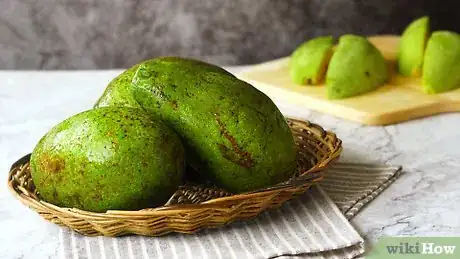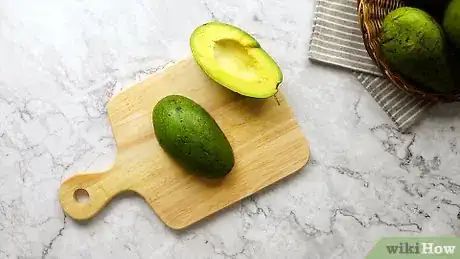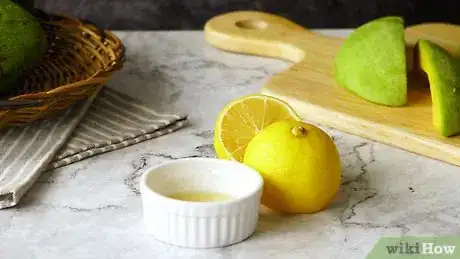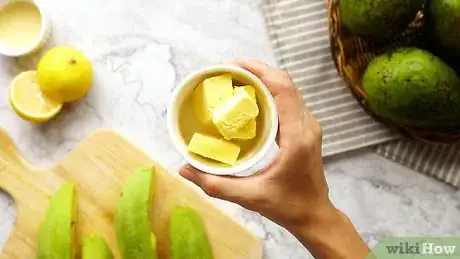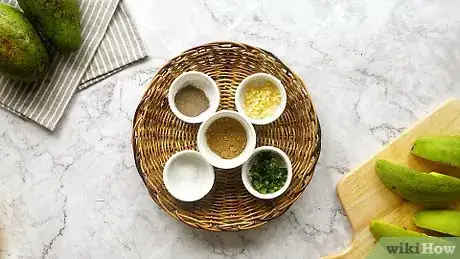This article was co-authored by wikiHow Staff. Our trained team of editors and researchers validate articles for accuracy and comprehensiveness. wikiHow's Content Management Team carefully monitors the work from our editorial staff to ensure that each article is backed by trusted research and meets our high quality standards.
There are 8 references cited in this article, which can be found at the bottom of the page.
The wikiHow Culinary Team also followed the article's instructions and verified that they work.
This article has been viewed 78,290 times.
Learn more...
Avocados are a healthy and delicious snack on their own, but if you're looking for a new way to incorporate avocados into your life, you can mix mashed avocado with butter and other ingredients to make a tasty alternative butter. Avocado butter is great for sandwiches, toast, crackers, dipping, and works great as an overall spread! All it takes is finding ripe avocados, and mixing them with butter and your favorite seasonings.
Ingredients
- 2 small, ripe avocados – about 6 ounces of avocado meat
- 1 tablespoon of freshly squeezed lemon juice
- 4 tablespoons of unsalted butter, at room temperature
- 1 clove garlic, minced
- 1 tablespoon fresh cilantro, chopped
- 2 teaspoons cumin, freshly toasted and ground
- Salt (to taste)
- Freshly ground black pepper (to taste)[1]
Steps
Choosing the Ingredients
-
1Acquire two small, ripe avocados. Search supermarkets, farmers markets, and local fruit stands. Look for avocados that are firm, unblemished, and uniformly brown. Review these qualities to determine whether an avocado is ripe:
- Check the color and appearance: Choose avocados without dark blemishes or deep indentations on the skin. California Hass avocados ripen into a dark green or black shade; if they are green at all, they probably aren't ripe. Florida avocados on the other hand, have lighter-green skin with a yellowish tone, even when they are ripe.[2]
- Feel the avocados for ripeness: Gently squeeze the avocado to test its firmness. Don't squeeze very hard with your fingertips, or you'll risk bruising the fruit. A ripe avocado is soft, but it gives in to the pressure of your thumb and other fingers. Under-ripe avocados will be firm and hard; overripe avocados will be mushy to the touch, and often unevenly so.[3]
- Check the spot where the stem meets the fruit: Use your fingernail to pick away the circular remainder of the stem. This should reveal a small hole in the skin through which you can note the color of the avocado. If the "meat" is green, it's either ripe or ripening. If the inside of the avocado looks brown, black, or any other color, it's either overripe or moldy.[4]
-
2Buy ripe, ready-to-eat avocados if you plan to make avocado butter immediately. Purchase unripe, firm avocados if you plan on using them in a few days. Store unripe avocados in a paper bag at room temperature between 65 and 75 degrees Fahrenheit (18.33 and 23.88 degrees Celsius) for up to 5 days or until they are ripe.[5]
- If you want to slow the ripening process, store your avocados in a refrigerator. Only ripe or soft avocados should be refrigerated. Ripe fruit can be refrigerated until it is eaten, and should last for at least two more days.
Advertisement -
3Use one tablespoon of fresh-squeezed lemon juice. The citric acid adds a tangy flavor, but its primary function is actually to preserve the avocado butter so that it will last longer. The citric acid also prevents the avocado butter from oxidizing and turning brown. If you don't add lemon juice, the avocado butter will begin to go brown within hours of preparation.
- If you don't have access to lemons, you can use any concentrated citrus juice: lime, orange, grapefruit, etc. Generally, the more sour the fruit, the more citric acid it contains. You could even use pre-bottled lemon or lime juice.
- Avoid using citrus juice that has been sweetened, pasteurized, or infused with chemical additives. Only use citrus concentrate.
-
4Use four tablespoons of room-temperature butter. You can also use margarine, a butter substitute, or 1/4 cup olive oil.[6] Lukewarm or room-temperature butter is much softer and more spreadable than cold butter. Because room temperature butter is softer, it's much easier to mix into avocado butter. If you have butter stored in the fridge, move it to room temperature and let it "thaw" before you use it.
- If you don't want to use butter, you can simply mash up the avocado with all of the other ingredients. Your butter-less "avocado butter" will not have quite the same texture as its buttery counterpart, but you'll be able to use it in all of the same situations.
-
5Choose your seasonings. The crux of the recipe is the avocado, the butter, and the citric acid – so everything else that you add is purely a matter of taste. Try adding one clove of minced garlic, one tablespoon of fresh-chopped cilantro, two teaspoons of cumin, and salt and pepper to taste.
- Feel free to use fewer seasonings for a simpler avocado butter, or more complex seasonings for a spicier butter. Try various seasoning combinations to figure out what you prefer.
Preparing Avocado Butter
-
1Wash the fruit before preparing it. Rinse each avocado under running water, and make sure that you wash it thoroughly. It doesn't matter whether you grew the avocado yourself or found it laying on the sidewalk, it's important that you rinse any chemicals and bacteria from your produce before you eat it.
- Dry the avocados with a clean towel afterwards to remove any persistent debris.
-
2Cut the avocado. Use a sharp knife to cut around the avocado lengthwise. Carefully place it on a cutting board, and start slicing at the top of the avocado. Rotate the avocado and knife so you cut around the entire avocado and meet up with the initial slit. Then hold the two halves of the avocado and twist them in opposite directions to open the fruit.
-
3Pit the avocado. Use a sharp, sturdy knife, and place the pit-containing half of the avocado on a cutting board. Thwack the knife solidly into the avocado pit (1/8-1/4 inch deep) so that it won't easily budge. Then, hold the avocado firmly and twist the knife (and attached pit) until the pit dislodges from the fruit. Tap or slide the pit off of the knife into a garbage can or compost bin.
- Exercise great caution when using a knife. If you don't want to use a knife, you can remove the put with a spoon.
- If you use a spoon, try to wedge your tool beneath the seed and separate it from the surrounding meat so that you can scoop out the pit.[7]
-
4Peel your avocados. Now that you have two avocado halves, cut the avocado halves in half again, to make 4 wedges. Then pull the dark outer skin away from the green flesh of the fruit. Peel the fruit by sliding your thumb in between the skin and meat of the fruit, and peel the skin back away from the meat.
- If you slice the avocados open and scoop out the meat using a spoon, you don't need to peel the avocado. However, many people favor peeling off the skin of the avocado because it ensures you retain the dark green, high-nutrient layer of avocado meat closest to the outer skin.
- Consider cutting away the tough area where the stem meets the avocado. If you don't remove it now, you might find it amid your avocado butter later![8]
-
5Mix and mash the avocado with the other ingredients. You can hand-mash the fruit in a bowl, or you can grind it in a food processor.[9] Either way, mash the avocado until there are no large chunks remaining.
- If you are hand-mashing the avocado, use a fork or a mortar and pestle. Chop the avocado into chunks first to make it easier to mash. You want the mixture to be smooth like guacamole.
- If you are using a blender or food processor, put the avocado chunks into the machine, add all of the ingredients, and close the lid. Process until there are no large remaining chunks. This method is best if you're making a large quantity of avocado butter – it will be much easier than hand-mashing.
Eating and Storing
-
1Eat your avocado butter. The avocado butter will be freshest if you eat it right after you prepare it. Consider refrigerating it for 1-4 hours (in a covered bowl, or wrapped in parchment paper) before eating, if you'd like it cold. Consider the following ideas for eating avocado butter:
- Spread avocado butter on toast. You can spread it thickly onto bread, English muffins, tortillas – anything onto which you'd spread regular butter.
- Use avocado butter in a sandwich. You can use a lot of avocado butter as the key ingredient, or you can spread it thinly onto the bread as a condiment. Be aware that the more butter you used to make your avocado butter, the less you may want to eat in one sitting.
- Mix avocado butter into a salad. This treat can make a great salad dressing. Serve it on the side, or toss it directly into the mix.
- Eat avocado butter with any number of snacks. Dip chips or crackers; spread onto deviled eggs; dip your french fries into it; or eat it straight.
-
2Store uneaten avocado butter in the fridge. You want to store the avocado butter in an air-tight container. To help the avocado keep its green color, you can put a layer of plastic wrap on top of the avocado butter (so it's touching the top surface).
- Fresh avocado butter should keep for three days in the refrigerator or a week in the freezer.[10]
-
3If you didn't add citric acid to the recipe, make sure to add it before storing. The avocado will begin to brown within a few hours if isn't protected with concentrated lemon, lime, orange, or grapefruit juice. Don't add more than a few drops – otherwise, you may impair the taste.
Warnings
- Don't use avocado butter in cakes or other baked things that require butter. The avocado will hinder the recipe, and the baked goods won't come out the same.⧼thumbs_response⧽
- Be very careful when handling a knife.⧼thumbs_response⧽
References
- ↑ http://altonbrown.com/avocado-compound-butter-recipe/
- ↑ http://www.californiaavocado.com/how-tos/how-to-choose-and-use-an-avocado
- ↑ http://www.slate.com/blogs/browbeat/2014/11/04/avocado_selection_how_pick_an_avocado_pit_it_and_tell_when_it_s_ripe_video.html
- ↑ http://www.thekitchn.com/use-this-simple-trick-to-determine-whether-an-avocado-is-ripe-inside-tips-from-the-kitchn-172933
- ↑ http://www.californiaavocado.com/how-tos/how-to-choose-and-use-an-avocado
- ↑ http://www.myrecipes.com/recipe/avocado-butter
- ↑ http://www.avocadocentral.com/how-to/how-to-cut-how-to-peel-prepare-avocados
- ↑ https://snapguide.com/guides/make-easy-garlic-avocado-butter/
- ↑ https://snapguide.com/guides/make-easy-garlic-avocado-butter/
About This Article
To make avocado butter, rinse 2 small, ripe avocados and cut them lengthwise to remove the pit and peel them from the skin. Then, place the flesh of the fruit in a bowl, and mix in 1 tablespoon of lemon juice, 4 tablespoons of unsalted butter, 1 clove of minced garlic, 1 tablespoon of chopped cilantro, and 2 teaspoons of ground cumin. Make sure the avocado butter is completely smooth with no lumps, and then serve the butter on crackers, toast, or a sandwich! For tips on selecting ingredients and storing the avocado butter, read on!
